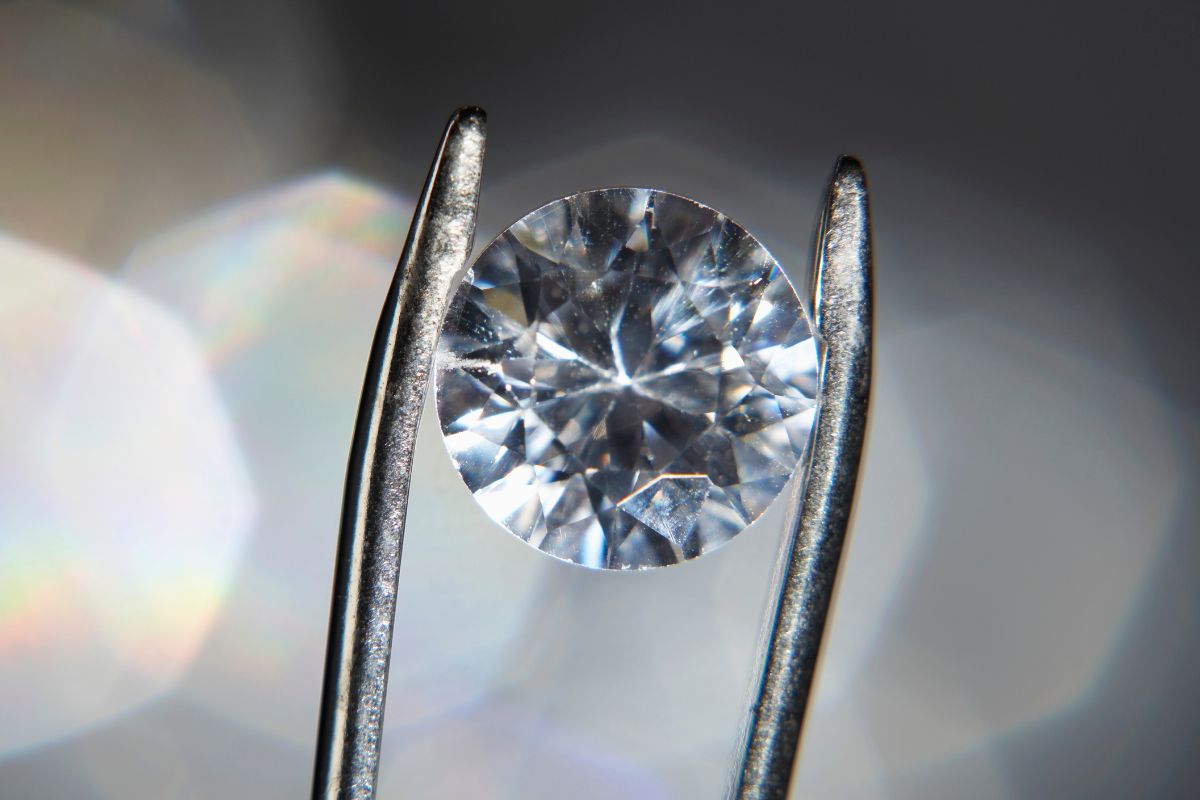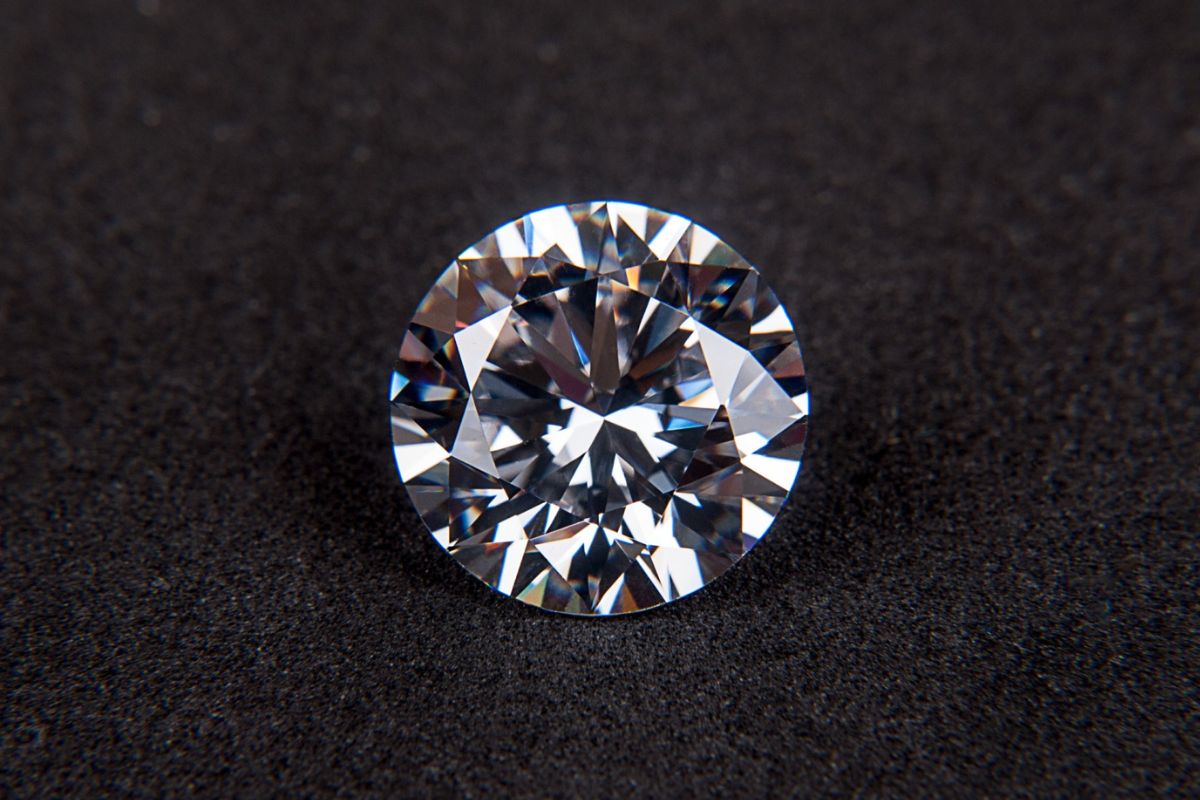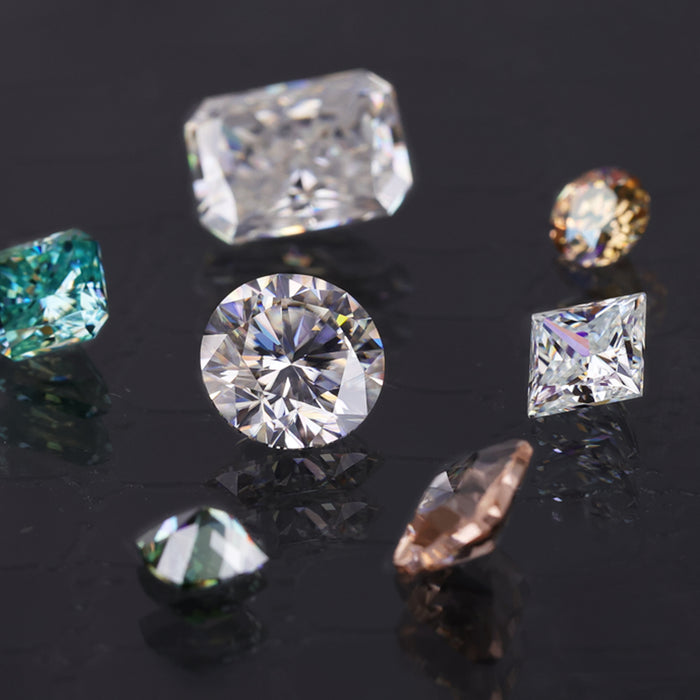When selecting a diamond, clarity is a critical factor that you will want to consider. Clarity refers to the presence of inclusions and blemishes within or on the surface of a diamond. These imperfections can range from minute, almost invisible flaws to more prominent inclusions that can affect the stone's sparkle. The best clarity for a diamond is one that doesn't have any inclusions visible to the naked eye, typically rated as "Flawless" or "Internally Flawless" in the diamond clarity scale. However, such diamonds are rare and highly prized, often commanding a premium price.
Table Of Contents
- The Basics of Diamond Clarity
- Factors Affecting Diamond Clarity
- Types of Inclusions and Blemishes
- Diamond Clarity and Beauty
- Selecting a Clarity Grade for Your Diamond
- High Clarity Diamond Grades
- Practical Tips for Diamond Buyers
- Advanced Clarity Considerations
- Differentiating Between Natural and Synthetic Diamonds
- Frequently Asked Questions
Understanding the clarity grading system can help you make an informed decision when choosing a diamond. The Gemological Institute of America (GIA) has established a detailed scale where clarity grades descend from Flawless, Internally Flawless, VVS1 and VVS2 (Very, Very Slightly Included), to VS1 and VS2 (Very Slightly Included), and further down to SI1 and SI2 (Slightly Included). If utmost clarity is your priority, you might focus on diamonds graded within the Flawless to VS categories.
Keep in mind that the right clarity grade for you also depends on other factors like the size of the diamond and its setting, as well as individual preferences and budget. Diamonds that are judged to be "eye-clean," meaning inclusions can't be seen without magnification, are typically considered suitable for jewelry and may provide a better balance between quality and value. The position, color, and type of inclusions also play a significant role in how they affect the diamond's appearance.
The Basics of Diamond Clarity
When selecting a diamond, clarity is a crucial aspect to consider because it defines the presence of inclusions and blemishes. These characteristics can influence the stone's beauty and value.
Understanding Clarity in Diamonds
Clarity refers to the absence of inclusions (internal characteristics) and blemishes (surface imperfections). When you look at a diamond, its clarity can greatly impact its sparkle and overall appearance. Jewelers commonly use 10x magnification to evaluate these features, as they are often not visible to the naked eye.
The GIA Diamond Clarity Scale
The GIA Diamond Clarity Scale classifies diamonds into categories based on how the inclusions and blemishes affect their appearance. Developed by the Gemological Institute of America (GIA), this scale is the industry standard for diamond clarity assessment.
Clarity Grades and What They Mean
Clarity grades range from Flawless (FL), where there are no inclusions or blemishes visible under 10x magnification, to Included (I), where inclusions and blemishes are obvious under 10x magnification and may affect transparency and brilliance.
- Flawless (FL): No inclusions or blemishes
- Internally Flawless (IF): No inclusions, only blemishes
- Very, Very Slightly Included (VVS1 and VVS2): Inclusions are difficult to see
- Very Slightly Included (VS1 and VS2): Inclusions are noticeable under 10x magnification
- Slightly Included (SI1 and SI2): Inclusions are easy to spot under 10x magnification
- Included (I1, I2, and I3): Inclusions are obvious and may affect the diamond's durability
Each grade reflects the diamond's clarity and, ultimately, its desirability. The higher the clarity, the rarer and more valuable the diamond typically is.
Factors Affecting Diamond Clarity
| Factor | Description |
|---|---|
| Nature of Inclusions | The type, size, and location of internal and external features (inclusions and blemishes). |
| Size of Inclusions | The dimensions of internal or external imperfections, impacting visibility. |
| Number of Inclusions | The quantity of internal or external flaws, affecting overall clarity grade. |
| Position of Inclusions | The location of imperfections within the diamond, determining their visibility and impact. |
| Color of Inclusions | The hue of internal or external features, which can affect the diamond's appearance. |
| Relief of Inclusions | The contrast or distinctness of inclusions against the background, affecting visibility. |
| Clarity Enhancement | Any treatments or enhancements applied to improve the diamond's visual clarity. |
| Shape and Cut | The impact of the diamond's shape and cut on the visibility and reflection of inclusions. |
When you're selecting the best clarity diamond, critical factors come into play, particularly inclusions and blemishes. A diamond's clarity can significantly influence its value, and understanding these elements helps in making an informed choice.
Evaluating Inclusions and Blemishes
Inclusions are internal characteristics such as crystals, feathers, and clouds, while blemishes refer to surface irregularities like scratches and nicks. The presence of these features is a natural outcome of the diamond's formation process. Their evaluation involves identifying the type and characteristics of each inclusion or blemish.
Size, Number, and Location of Inclusions
The size of an inclusion matters; larger inclusions generally have a more significant impact on the clarity grade. The number of inclusions within a diamond can also affect its clarity. Multiple inclusions can diminish transparency and brilliance. The location is critical as well; inclusions at the center of a diamond are more noticeable than those near the edges.
Assessing Clarity Under Magnification
To accurately assess clarity, a magnification tool, such as a microscope or loupe, is essential. Diamonds are graded at 10x magnification to determine how inclusions and blemishes affect their overall appearance. Under magnification, you can see the attributes that are invisible to the naked eye.
Types of Inclusions and Blemishes

In your search for the ideal diamond, understanding inclusions and blemishes is crucial as they can impact its value and appearance. Here’s a detailed look at what you may encounter within and on the surface of a diamond.
Identifying Common Inclusions
Inclusions are internal features that occur naturally during diamond formation. Here are some typical kinds you may encounter:
- Feather: A small crack within the stone that may affect durability.
- Crystal: A mineral deposit trapped inside the diamond; it can be another diamond or a different mineral.
- Cloud: A group of pinpoints or tiny crystals that appear hazy.
- Pinpoints: Extremely small light or dark crystals that may form a constellation.
- Cavity: A hole that is usually the result of an inclusion being removed during polishing or it may develop naturally.
- Graining: Irregular crystal growth that can manifest as lines or waves within the diamond.
Characterizing Surface Blemishes
Surface blemishes are imperfections on a diamond's exterior. Below are common surface blemishes you should be aware of:
- Scratches: Fine lines on the surface, usually from wear or the cutting process.
- Nicks: Small chips typically found along facet junctions or the girdle.
- Pits: Small holes on the surface of a diamond.
- Polish Lines: Minute lines left by polishing that are typically invisible without magnification.
Knowing these imperfections can guide you in choosing a diamond that balances natural characteristics with your personal standards for clarity.
Diamond Clarity and Beauty

When selecting a diamond, clarity is a critical factor as it directly influences your diamond's brilliance and overall appearance. Understanding the clarity scale, from flawless to included, is essential in making an informed choice that balances aesthetics and budget.
Impact of Clarity on Brilliance and Sparkle
Diamond clarity affects how light interacts with the gemstone's internal characteristics, often referred to as inclusions. A high clarity diamond has few to no inclusions, allowing light to pass through it unimpeded, which maximizes both brilliance—the diamond's ability to reflect white light—and sparkle, the playful flashes of color that emit from the diamond as it moves. A grading scale, such as the GIA Clarity Scale, classifies diamonds from Flawless to Included, with gradations such as Very Slightly Included (VS) and Slightly Included (SI) indicating the presence and visibility of inclusions.
Visibility of Inclusions to the Naked Eye
The term "naked eye" refers to the visibility of inclusions without the aid of magnification. For many, choosing a diamond that is clean to the naked eye is a crucial aspect of their selection. Diamonds graded as Very Slightly Included (VS) typically have inclusions that are not visible to the untrained eye when viewed from above, which can be a sweet spot between clarity and value. In contrast, diamonds categorized as Slightly Included (SI) may have inclusions that are visible to the naked eye, depending on the size, location, and color of the blemish. Here, personal preference plays a significant role, as some may find the unique "birthmarks" of a diamond an appealing feature that adds character, while others may prefer the uniform transparency and uninterrupted light performance of a higher clarity stone.
Selecting a diamond is a balance of these clarity characteristics with other qualities like cut and color, each contributing to the stone's final beauty and appeal.
Selecting a Clarity Grade for Your Diamond
When choosing a clarity grade for your diamond, you need to consider how inclusions and blemishes affect its appearance and value relative to its carat weight, cut, and color.

Choosing Between Clarity Grades
Diamond clarity refers to the absence of inclusions and blemishes and is graded from Flawless (FL) to Included (I1, I2, I3). Higher clarity grades like VVS1 and VVS2 denote very very slightly included diamonds—these have minute imperfections that are difficult for even a skilled grader to see under 10x magnification. Slightly included diamonds—graded VS1 and VS2—have inclusions that are observable with effort under magnification, but they are typically not visible to the naked eye. SI grades diamonds (SI1, SI2) include inclusions that are visible under magnification and may sometimes be seen with the naked eye, while I1 graded diamonds have inclusions that are usually visible without magnification.
Balancing Clarity with Other 4Cs
The 4Cs of diamond quality—cut, color, clarity, and carat weight—should be balanced according to your preferences and budget. A diamond's cut influences its sparkle, while its color can range from colorless (graded D) to light yellow or brown. Carat weight measures a diamond's size. If you’re on a limited budget, you might opt for a higher cut and color quality at a lower clarity grade, like SI1 or VS2, which can offer a better overall appearance for the price.
Understanding Price Variations with Clarity
Price variations with clarity can be substantial. For example, VVS1 and VVS2 diamonds will command higher prices due to their higher clarity grades. Comparatively, SI1 and SI2 diamonds often present much better value, as their inclusions may not affect the stone's visual splendor, especially when they are well-positioned or less noticeable. A 1-carat VVS1 diamond could be significantly more expensive than a 1-carat SI2 diamond of similar cut and color, reflecting the rarity of high-clarity grades. Always consider how much importance you place on a diamond's clarity compared to its other qualities and how this affects your budget.
High Clarity Diamond Grades

When selecting a diamond, understanding clarity grades is essential for ensuring you get a gem that meets your specific standards. High clarity diamonds are categorized based on the presence or absence of inclusions and blemishes, with grades reflecting their relative visibility under magnification.
Flawless and Internally Flawless Diamonds
Flawless (FL) diamonds are the pinnacle of clarity, completely free of inclusions and external blemishes when observed by a skilled grader using 10x magnification. Internally Flawless (IF) diamonds share this lack of inclusions but may have insignificant surface blemishes.
Very, Very Slightly Included Diamonds
The Very, Very Slightly Included category comprises two grades: VVS1 and VVS2. Diamonds graded VVS1 have inclusions that are extremely difficult to see, even for a seasoned grader, while VVS2 graded gems have inclusions that are only slightly more visible under magnification.
Slightly Included and Included Grades
Diamonds that exhibit inclusions visible under 10x magnification fall into the Slightly Included (SI) group, which is divided into SI1 and SI2 grades. Your SI1 diamond will have inclusions that are noticeable to a trained eye, whereas SI2 diamonds present inclusions that are more apparent. The Included category, including I2 and I3 grades, contains diamonds with inclusions that may affect transparency and brilliance.
Practical Tips for Diamond Buyers

When investing in a diamond, knowing how to assess and choose the right clarity can significantly impact both its beauty and value. Clarity is a critical factor, especially when selecting engagement rings. Pay close attention to the diamond's clarity and aim to find an eye-clean diamond that meets your budget.
How to Inspect a Diamond for Clarity
To properly inspect a diamond's clarity, you'll need a jeweler's loupe. This magnification tool will allow you to view inclusions or blemishes that are not visible to the naked eye. When using a loupe, inspect the diamond under proper lighting and from various angles. A trained diamond grader can help you understand the specific clarity characteristics of each stone.
- Clean the diamond before inspection.
- Hold the loupe steadily and bring it up to your eye.
- Examine the diamond from the top (table) and the sides.
- Look for any imperfections, known as inclusions (inside) and blemishes (surface).
Choosing an Eye-Clean Diamond on a Budget
Eye-clean diamonds are stones that have no inclusions visible to the naked eye when viewed from a normal distance. They provide excellent value for those on a budget. Here are tips to find eye-clean diamonds within your budget:
- Request only those diamonds graded as SI (Slightly Included) or higher for consideration.
- View diamonds in person if possible, as some inclusions are not visible in photographs.
Tip: When on a budget, prioritize a diamond's cut and color over clarity to get the best overall appearance.
Considering Clarity in Engagement Rings
Clarity plays a pivotal role when selecting an engagement ring. Since this piece of jewelry is a symbol of your commitment and will be worn regularly, it’s important that the diamond maintains its sparkle over time.
- Discuss with a gemologist or experienced jeweler about the best clarity options for your ring.
- Balance clarity with other factors, like cut and color, to ensure the ring sparkles and fits within your budget.
Remember: A higher clarity grade can mean a higher cost, so choose a clarity level that does not compromise the overall beauty of the ring while still aligning with your budget expectations.
Advanced Clarity Considerations
When you're evaluating diamonds for purchase, it is essential to understand how treatments and enhancements, as well as inherent clarity characteristics, can affect the overall appearance and value, particularly in fancy shape diamonds like the emerald and Asscher cuts.
Treatment and Enhancement Effects
- Laser Drilling: Diamonds often undergo laser drilling to remove inclusions. This process involves using a laser to bore a tiny hole into the diamond to burn away black carbon deposits. The drill hole is typically microscopic and may lead to decreased clarity if not done properly.
- Fracture Filling: This enhancement hides cracks in diamonds by injecting a glass-like substance into them. While effective in improving the visual clarity, fracture filling can alter the way a diamond reacts to light and heat, sometimes resulting in a less durable stone. It is important for you to check if a diamond has been fracture-filled, as this affects both value and care requirements.
Clarity Characteristics in Fancy Shapes

- Emerald Cut: The emerald cut, known for its step cuts and long, open table, highlights a diamond's clarity. Due to its large table, inclusions and imperfections are more visible to the naked eye, necessitating higher clarity grades for a visually flawless appearance.
- Asscher Cut: Similar to emerald cuts, the Asscher cut also exhibits step cuts, but with a square shape. It shares the same clarity considerations, where inclusions are more noticeable. Before purchase, examine the clarity plot on the diamond's certificate, which maps the diamond's internal characteristics, to ensure you're comfortable with the placement and type of inclusions.
- Plotting Diagram: The plotting diagram on a diamond's certificate provides a map of a diamond's inclusions. For fancy shapes like emerald and Asscher cuts, scrutinize the diagram closely as inclusions near the center or along the corners can impact a diamond's aesthetic, potentially reducing its value.
- Shape and Clarity: The shape of a diamond affects how prominently inclusions are displayed. Fancy shapes vary widely in how clarity imperfections are revealed, and selecting a shape should align with your clarity preferences and tolerance for visible flaws.
Remember that treatments may improve a diamond’s initial appeal but could also affect the longevity and value. Always review the diamond certification for details on clarity and any enhancements before making a decision.
Differentiating Between Natural and Synthetic Diamonds
| Aspect | Natural Diamonds | Synthetic Diamonds |
|---|---|---|
| Formation | Formed naturally deep within the Earth's mantle over millions of years. | Created in a controlled laboratory environment using advanced technological processes. |
| Inclusions | May contain a variety of natural inclusions, such as minerals or crystals. | Typically has fewer or no natural inclusions due to controlled growth conditions. |
| Cost | Can be more expensive, with prices influenced by factors like rarity and size. | Generally more affordable than natural diamonds. |
| Clarity | Clarity grading considers natural inclusions and blemishes. | May achieve higher clarity grades due to controlled growth conditions. |
| Environmental Impact | Mining natural diamonds has environmental considerations and resource extraction. | May be considered a more environmentally friendly option due to reduced environmental impact. |
| Color | Can exhibit a wide range of natural colors, including colorless, yellow, brown, and rare fancy colors. | Can be produced in a variety of colors, and color is often controlled during the manufacturing process. |
When you're considering a diamond purchase, understanding the distinctions between natural and synthetic diamonds is crucial. Natural diamonds have formed over billions of years under high-pressure and high-temperature conditions deep within the Earth, making them rare and often more valued. Synthetic diamonds, also known as lab-grown or cultured diamonds, replicate these natural processes through advanced technology, providing alternatives with comparable physical and chemical characteristics. Clarity, an important aspect of a diamond's quality, can vary between these two types due to their formation processes and environments.
Clarity Features in Natural Diamonds
Natural diamonds can contain unique internal inclusions or surface blemishes which are often microscopic. These characteristics are commonly referred to as a diamond's 'birthmarks'. The Gemological Institute of America (GIA) grades natural diamond clarity on a scale ranging from Flawless (FL) to Included (I3). Higher clarity grades are rarer and increase the diamond's value.
- Type Ia: Most natural diamonds fall into this category, containing nitrogen impurities.
- Type IIa: Less than 2% of natural diamonds are in this category, often featuring the highest clarity and absence of detectable nitrogen.
Assessing Clarity in Lab-Grown Diamonds
Lab-grown diamonds are assessed for clarity using the same standards applied to natural diamonds. Gemological labs employ skilled gemologists to evaluate each diamond under controlled lighting and viewing conditions. Synthetic diamonds, particularly those grown by Chemical Vapor Deposition (CVD), might display different inclusions like metallic flakes or growth lines that are indicative of their formation process.
- Chemical Vapor Deposition (CVD): This synthetic process may produce diamonds with a characteristic that can reveal their lab-grown nature.
- High Pressure High Temperature (HPHT): Another synthetic method which can create diamonds that may contain metallic inclusions or have a certain level of strain in their crystal structure, invisible to the naked eye but can be detected by trained professionals.
When assessing the clarity of lab-grown diamonds it's key to understand that:
- Inclusions are inevitable but the type and visibility differ from natural diamonds.
- The GIA also grades lab-grown diamonds, and these grades are reflected in the clarity grade stated on the certificate accompanying the diamond.
By being informed of these clarity features and assessments, you can make a confident decision about the quality and origin of your diamond.
Frequently Asked Questions
Understanding clarity is crucial for evaluating diamonds. These FAQs will address key aspects of diamond clarity, each grade's meaning, and how it affects a diamond's value and appearance.
What does each grade on the diamond clarity chart represent?
The clarity chart categorizes diamonds based on the presence of inclusions and blemishes. Grades range from Flawless (FL), without any inclusions or blemishes visible under 10x magnification, to Included (I1, I2, and I3), where inclusions are evident and may affect transparency and brilliance.
How does GIA grading affect a diamond's clarity and value?
The Gemological Institute of America (GIA) clarity grading provides a standard measure that assesses how inclusions and blemishes impact a diamond's appearance. The clearer the diamond (with a higher GIA grade), the rarer and often more valuable it is.
What is the importance of balancing diamond color and clarity when selecting a gemstone?
Both color and clarity translate to a diamond's overall aesthetics, with an optimal balance enhancing a diamond's fire, brilliance, and value. Focusing on a harmonious blend often yields a more visually appealing diamond within your budget.
What characteristics define the highest quality diamonds?
The highest quality diamonds are graded as Flawless or Internally Flawless (IF), exhibiting no inclusions or blemishes when viewed under 10x magnification and possessing exceptional transparency and brilliance.
How do VS1 and VS2 clarity ratings compare for diamonds?
VS1 and VS2 are Very Slightly Included categories, with inclusions difficult to see under 10x magnification. VS1 inclusions are challenging to detect, while VS2 inclusions are somewhat easier to see but still minor, often making VS1 a pricier option.
What impact does a diamond's carat weight have on its overall appearance and worth?
Carat weight influences a diamond's size and, along with clarity, color, and cut, affects its value. Larger diamonds are rarer and more desirable, but only if clarity, color, and cut grades uphold a high standard to ensure brilliance and beauty.
Checkout some of our top collections:








